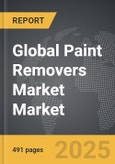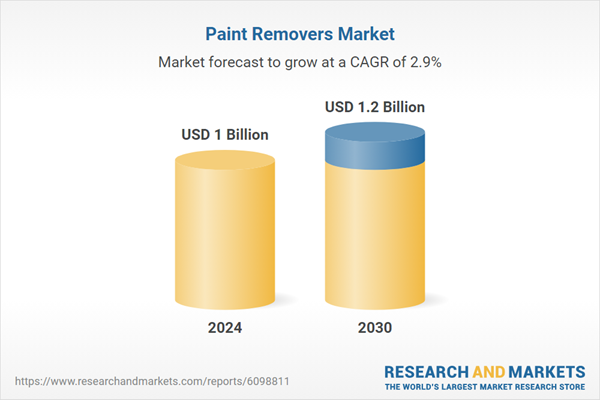Global Paint Removers Market - Key Trends & Drivers Summarized
Why Are Paint Removers Evolving from Conventional Solvent-Based Formulas to Safer, Eco-Friendly Alternatives?
Paint removers, also known as paint strippers, are chemical formulations used to dissolve and remove paint, coatings, varnish, or lacquers from surfaces such as wood, metal, masonry, and plastics. Historically dominated by solvent-based products containing methylene chloride, the market is undergoing a radical transformation in response to health, safety, and environmental concerns. Regulatory bans on hazardous ingredients in many countries have catalyzed the shift toward safer, bio-based, and water-based alternatives that minimize risks to both users and the environment.Consumer awareness and stricter workplace safety mandates are pushing manufacturers to reformulate products without compromising efficacy. Paint removers are now expected to deliver high stripping performance with low volatility, reduced odor, and improved substrate compatibility. As demand expands across industrial, commercial, and residential segments - including furniture restoration, automotive refinishing, and infrastructure maintenance - users are seeking products that comply with environmental regulations while maintaining efficiency and ease of use. This evolving regulatory landscape is redefining innovation priorities across the global paint removers market.
How Are Formulation Science and Application Technologies Enhancing Product Safety and Effectiveness?
New-generation paint removers incorporate solvents like N-methyl-2-pyrrolidone (NMP)-free blends, dibasic esters, benzyl alcohol, and lactic acid, delivering comparable stripping power with lower human and environmental toxicity. Gel-based and paste formulations enhance cling and contact time on vertical surfaces, reducing application frequency and runoff. Enzymatic and bio-based formulations are also entering the market, offering non-corrosive, VOC-compliant options suitable for delicate substrates such as antiques or marine vessels.Sprayable, aerosol, and brush-on delivery mechanisms are being optimized to reduce waste, increase surface coverage, and ensure user control. Heat-activated removers and smart gel systems with color-change indicators are gaining traction for their precision and effectiveness. Packaging innovations such as resealable containers, child-resistant caps, and recyclable materials are further aligning with sustainability goals. These advancements not only enhance user safety and environmental compliance but also broaden product appeal across professional and DIY applications.
Which End-Use Segments and Geographies Are Driving Demand for Advanced Paint Removers?
The construction and renovation sector remains a major consumer of paint removers, particularly for surface preparation and maintenance in residential and commercial buildings. Automotive aftermarket services use paint removers for refinishing, restoration, and repainting workflows, where material compatibility and finish preservation are critical. Industrial applications include pipeline coating removal, machinery repainting, and marine surface maintenance - often requiring high-performance formulations capable of cutting through multiple coating layers.North America and Europe lead the global market, with stringent regulations from the U.S. EPA, OSHA, and the EU REACH framework prompting the development and adoption of safer alternatives. Asia-Pacific is witnessing rapid growth, driven by expanding construction activity, urban redevelopment, and a rising middle-class DIY culture in countries like China, India, and Indonesia. Latin America and the Middle East are increasingly adopting compliant, export-friendly products to meet evolving trade and safety standards. Across all regions, eco-label certifications and VOC-compliance are becoming critical purchasing criteria.
What Is Fueling Long-Term Growth and Competitive Innovation in the Paint Removers Market?
The growth in the paint removers market is driven by the convergence of regulatory pressure, sustainability goals, and professional demand for high-performance, user-safe products. As methylene chloride-based removers face global restrictions, demand is shifting toward green chemistry solutions that meet safety, efficacy, and environmental benchmarks. Institutional buyers - such as schools, government contractors, and healthcare facilities - are mandating low-toxicity products for interior use, further reinforcing the market transition.Strategically, companies are investing in R&D for low-odor, biodegradable, and multi-coat-compatible formulations. Strategic branding emphasizes non-carcinogenic, fume-free, and residue-free performance, with user education through videos, tutorials, and mobile applications. Partnerships with home improvement retailers and contractor supply chains are strengthening market reach. In the long run, growth will depend on the balance between regulatory compliance, stripping power, and user convenience - positioning the paint removers market as an intersection of industrial efficiency and green innovation.
Report Scope
The report analyzes the Paint Removers market, presented in terms of market value (US$). The analysis covers the key segments and geographic regions outlined below:- Segments: Material (Solvent, Caustic, Acidic, Other Materials); Grade (Industrial Grade, Technical Grade, Commercial Grade); Application (Vehicle Maintenance, Industrial Repair, Building Renovation, Furniture Refinishing, Other Applications); End-Use (Building & Construction, Aerospace & Defense, Automotive, Marine, Industrial, Other End-Uses).
- Geographic Regions/Countries: World; United States; Canada; Japan; China; Europe (France; Germany; Italy; United Kingdom; Spain; Russia; and Rest of Europe); Asia-Pacific (Australia; India; South Korea; and Rest of Asia-Pacific); Latin America (Argentina; Brazil; Mexico; and Rest of Latin America); Middle East (Iran; Israel; Saudi Arabia; United Arab Emirates; and Rest of Middle East); and Africa.
Key Insights:
- Market Growth: Understand the significant growth trajectory of the Solvent Material segment, which is expected to reach US$439.3 Million by 2030 with a CAGR of a 2.4%. The Caustic Material segment is also set to grow at 2.5% CAGR over the analysis period.
- Regional Analysis: Gain insights into the U.S. market, valued at $277.5 Million in 2024, and China, forecasted to grow at an impressive 5.4% CAGR to reach $234.2 Million by 2030. Discover growth trends in other key regions, including Japan, Canada, Germany, and the Asia-Pacific.
Why You Should Buy This Report:
- Detailed Market Analysis: Access a thorough analysis of the Global Paint Removers Market, covering all major geographic regions and market segments.
- Competitive Insights: Get an overview of the competitive landscape, including the market presence of major players across different geographies.
- Future Trends and Drivers: Understand the key trends and drivers shaping the future of the Global Paint Removers Market.
- Actionable Insights: Benefit from actionable insights that can help you identify new revenue opportunities and make strategic business decisions.
Key Questions Answered:
- How is the Global Paint Removers Market expected to evolve by 2030?
- What are the main drivers and restraints affecting the market?
- Which market segments will grow the most over the forecast period?
- How will market shares for different regions and segments change by 2030?
- Who are the leading players in the market, and what are their prospects?
Report Features:
- Comprehensive Market Data: Independent analysis of annual sales and market forecasts in US$ Million from 2024 to 2030.
- In-Depth Regional Analysis: Detailed insights into key markets, including the U.S., China, Japan, Canada, Europe, Asia-Pacific, Latin America, Middle East, and Africa.
- Company Profiles: Coverage of players such as Actavis, Amneal Pharmaceuticals, Arevipharma GmbH, Bristol-Myers Squibb Company, Camber Pharmaceuticals and more.
- Complimentary Updates: Receive free report updates for one year to keep you informed of the latest market developments.
Some of the 44 companies featured in this Paint Removers market report include:
- 3M Company
- Akzo Nobel N.V.
- Asian Paints Limited
- Citristrip
- Dumond Chemicals, Inc.
- EZ Strip Inc.
- Fiberlock Technologies
- Franmar Chemical, Inc.
- Henkel AG & Co. KGaA
- Jasco Products Company
- Klean-Strip
- Motsenbocker's Lift Off
- Nippon Paint Holdings Co., Ltd.
- PPG Industries, Inc.
- RPM International Inc.
- Rust-Oleum Corporation
- Savogran Company
- Sherwin-Williams Company
- Sunnyside Corporation
- Vitex Corporation
This edition integrates the latest global trade and economic shifts into comprehensive market analysis. Key updates include:
- Tariff and Trade Impact: Insights into global tariff negotiations across 180+ countries, with analysis of supply chain turbulence, sourcing disruptions, and geographic realignment. Special focus on 2025 as a pivotal year for trade tensions, including updated perspectives on the Trump-era tariffs.
- Adjusted Forecasts and Analytics: Revised global and regional market forecasts through 2030, incorporating tariff effects, economic uncertainty, and structural changes in globalization. Includes historical analysis from 2015 to 2023.
- Strategic Market Dynamics: Evaluation of revised market prospects, regional outlooks, and key economic indicators such as population and urbanization trends.
- Innovation & Technology Trends: Latest developments in product and process innovation, emerging technologies, and key industry drivers shaping the competitive landscape.
- Competitive Intelligence: Updated global market share estimates for 2025, competitive positioning of major players (Strong/Active/Niche/Trivial), and refined focus on leading global brands and core players.
- Expert Insight & Commentary: Strategic analysis from economists, trade experts, and domain specialists to contextualize market shifts and identify emerging opportunities.
Table of Contents
Companies Mentioned (Partial List)
A selection of companies mentioned in this report includes, but is not limited to:
- 3M Company
- Akzo Nobel N.V.
- Asian Paints Limited
- Citristrip
- Dumond Chemicals, Inc.
- EZ Strip Inc.
- Fiberlock Technologies
- Franmar Chemical, Inc.
- Henkel AG & Co. KGaA
- Jasco Products Company
- Klean-Strip
- Motsenbocker's Lift Off
- Nippon Paint Holdings Co., Ltd.
- PPG Industries, Inc.
- RPM International Inc.
- Rust-Oleum Corporation
- Savogran Company
- Sherwin-Williams Company
- Sunnyside Corporation
- Vitex Corporation
Table Information
| Report Attribute | Details |
|---|---|
| No. of Pages | 491 |
| Published | December 2025 |
| Forecast Period | 2024 - 2030 |
| Estimated Market Value ( USD | $ 1 Billion |
| Forecasted Market Value ( USD | $ 1.2 Billion |
| Compound Annual Growth Rate | 2.9% |
| Regions Covered | Global |









